rear view mirror BUICK LESABRE 1993 Owners Manual
[x] Cancel search | Manufacturer: BUICK, Model Year: 1993, Model line: LESABRE, Model: BUICK LESABRE 1993Pages: 324, PDF Size: 17.02 MB
Page 102 of 324
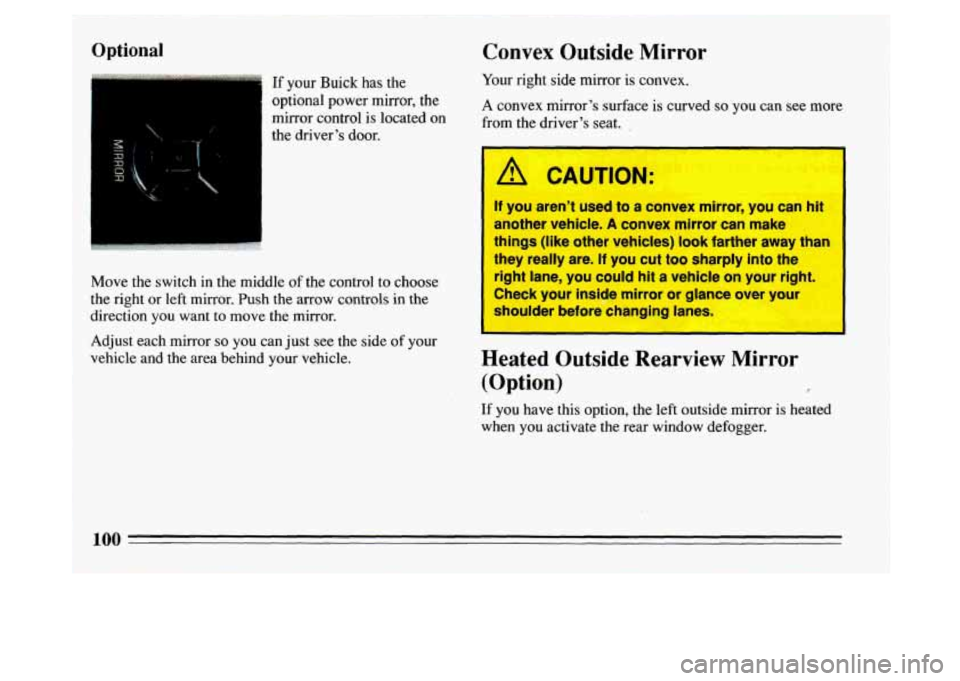
Optional Convex Outside Mirror
Move the switch in the middle of the control to choose
the right or left mirror. Push the arrow controls in the
direction you want to move the mirror.
Adjust each mirror
so you can just see the side of your
vehicle and the area behind your vehicle.
1 A CAUTION:
If your Buick has the Your right side mirror is convex.
optional power mirror, the A convex mirror’s surface is curv\
ed
so you can see more
the driver’s door. mirror Control is located
On from the driver’s seat,
I - -
If you aren’t used to a convex mirror, you can hit
another vehicle. A convex mirror can make
things (like other vehicles) look farther away than
they really are.
If you cut too sharply into the
right lane, you could hit
a vehicle on your right.
Check your inside mirror or glance over your
shoulder before changing lanes.
Heated Outside Rearview Mirror (Option)
r
If you have this option, the left outside mirror is heated
when you activate the rear window defogger.
100
Page 126 of 324
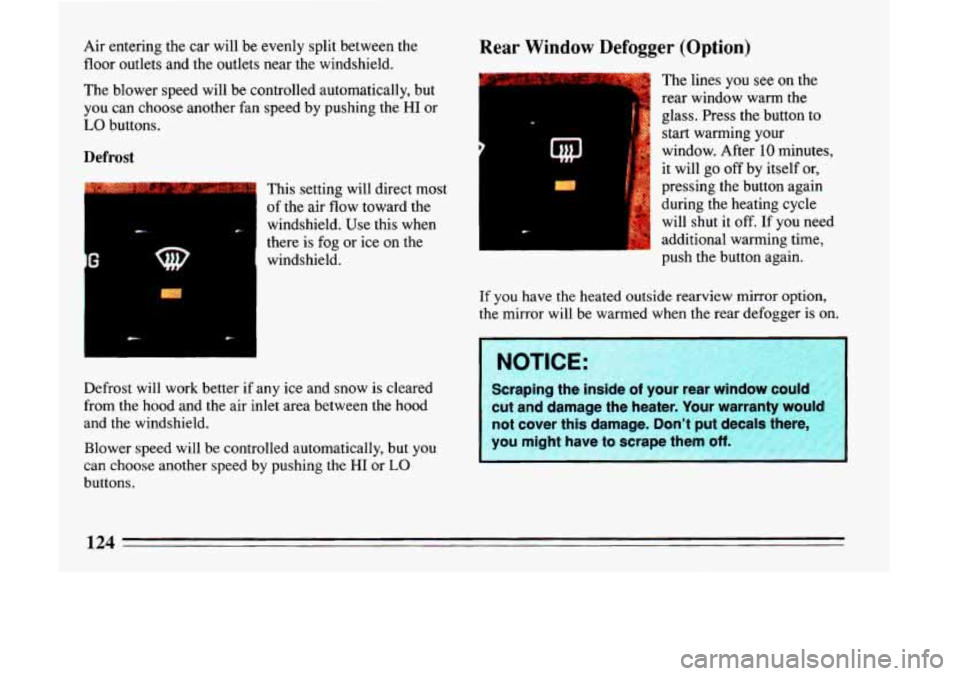
Air entering the car will be evenly split between the
floor outlets and
the outlets near the windshield.
The blower speed will be controlled automatically,
but
you can choose another fan speed by pushing the HI or
LO buttons.
Defrost
This setting will direct most
of the air flow toward the
windshield. Use this when
there is fog or ice on the
I windshield.
Defrost will work better if any ice and snow is cleared
from the hood and the air inlet area between
the hood
and
the windshield.
Blower speed will be controlled automatically, but
you
can choose another speed by pushing the HI or LO
buttons.
Rear Window Defogger (Option)
The lines you see on the
rear window warm the
glass. Press the button to
start warming your
window. After
10 minutes,
it will go
off by itself or,
pressing the button again
during the heating cycle
will shut it
off. If you need
additional warming time,
push the button again.
If you have the heated outside rearview mirror option,
the mirror will be warmed when the rear defogger is on.
I NOTICE:
Scraping the inside of your rear winoow could
cut and damage the heater. Your warranty wou’” not cover this damage. Don’t put decal? +here,
you might have to scrape them off.
Page 171 of 324
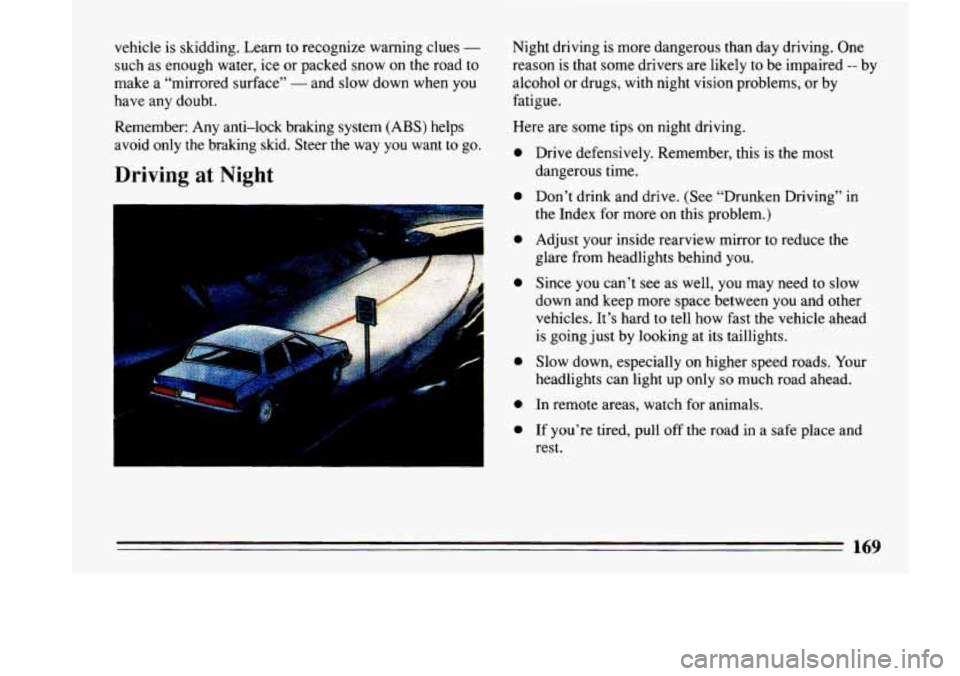
vehicle is skidding. Learn to recognize warning clues -
such as enough water, ice or packed snow on the road to
make a “mirrored surface”
- and slow down when you
have any doubt.
Remember: Any anti-lock braking system (ABS) helps
avoid only the braking skid. Steer the way
you want to go.
Driving at Night
Night driving is more dangerous than day driving. One
reason is that some drivers are likely
to be impaired -- by
alcohol or drugs, with night vision problems, or by
fatigue.
Here are some tips on night driving.
0
0
0
0
0
0
0
Drive defensively. Remember, this is the most
dangerous time.
Don’t drink and drive, (See “Drunken Driving’’ in
the Index for more
on this problem.)
Adjust your inside rearview mirror to reduce the
glare from headlights behind you.
Since you can’t see as well,
you may need to slow
down and keep more space between you and other
vehicles. It’s hard to tell
how fast the vehicle ahead
is going just by looking at its taillights.
Slow down, especially on higher speed roads. Your
headlights can light up only
so much road ahead.
In remote areas, watch for animals.
If you’re tired, pull off the road in a safe place and
rest.
169
Page 178 of 324
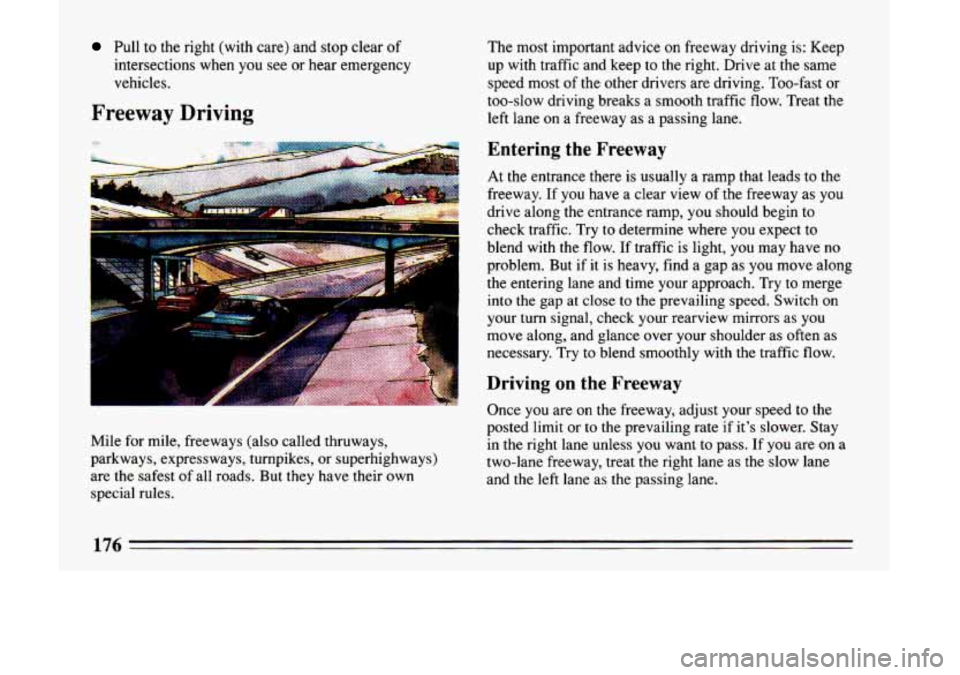
Pull to the right (with care) and stop clear of
intersections
when you see or hear emergency
vehicles.
Freeway Driving
The most important advice on freeway driving is: Keep up
with traffic and keep to the right. Drive at the same
speed most
of the other drivers are driving. Too-fast or
too-slow driving breaks
a smooth traffic flow. Treat the
left lane on a freeway as a passing lane.
Mile for mile, freeways (also called thruways,
parkways, expressways, turnpikes, or superhighways)
are the safest
of all roads. But they have their own
special rules.
Entering the Freeway
At the entrance there is usually a ramp that leads to the
freeway. If you have a clear view of the freeway as you
drive along the entrance ramp, you should begin to
check traffic. Try
to determine where you expect to
blend with
the flow. If traffic is light, you may have no
problem. But if
it is heavy, find a gap as you move along
the entering lane and time your approach. Try
to merge
into the gap at
close to the prevailing speed. Switch on
your turn signal, check your rearview mirrors as you
move along, and glance over your shoulder as often as
necessary. Try
to blend smoothly with the traffic flow.
Driving on the Freeway
Once you are on the freeway, adjust your speed to the
posted limit or
to the prevailing rate if it’s slower. Stay
in the right lane unless you want to pass. If you are on a
two-lane freeway, treat the right lane as the slow lane
and the left lane as the passing lane.
Page 179 of 324
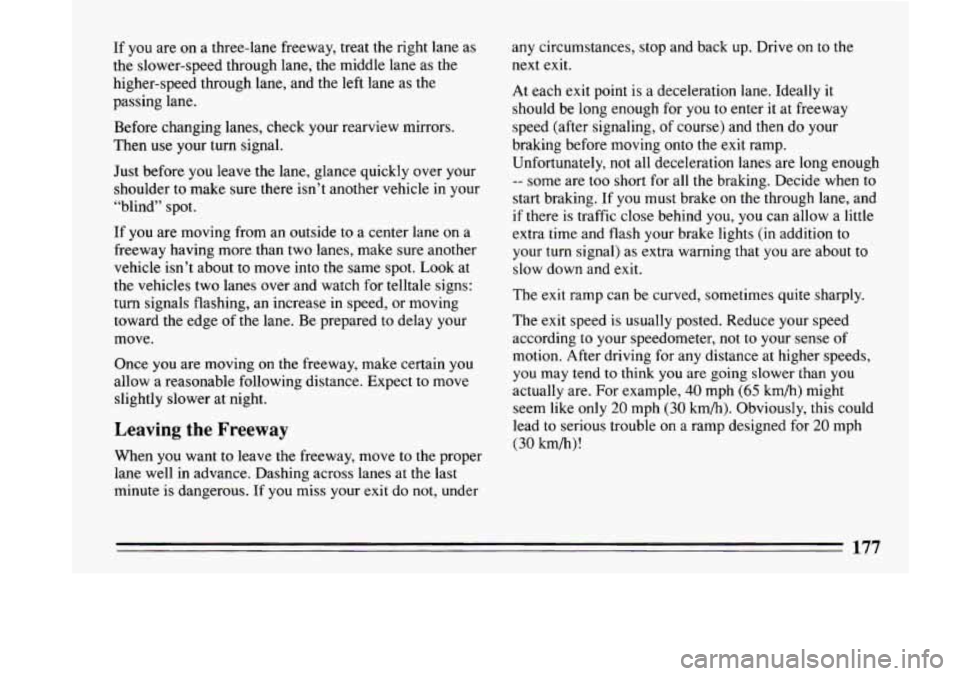
If you are on a three-lane freeway, treat the right lane as
the slower-speed through lane, the middle lane as the
higher-speed through lane, and the left lane
as the
passing lane.
Before changing lanes, check your rearview mirrors.
Then use your turn signal.
Just before
you leave the lane, glance quickly over your
shoulder to make sure there isn’t another vehicle in your
“blind” spot.
If you are moving from an outside
to a center lane on a
freeway having more than two lanes, make sure another
vehicle isn’t about to move into the same spot. Look at
the vehicles two lanes over and watch for telltale signs:
turn signals flashing, an increase in speed, or moving
toward the edge of the lane. Be prepared
to delay your
move.
Once
you are moving on the freeway, make certain you
allow
a reasonable following distance. Expect to move
slightly slower at night.
Leaving the Freeway
When you want to leave the freeway, move to the proper
lane well in advance. Dashing across lanes at the last
minute
is dangerous. If you miss your exit do not, under any circumstances, stop
and back up. Drive
on to the
next exit.
AI each exit point is a deceleration lane. Ideally it
should
be long enough for you to enter it at freeway
speed (after signaling,
of course) and then do your
braking before moving onto the exit ramp.
Unfortunately,
not all deceleration lanes are long enough
-- some are too short for all the braking. Decide when to
start braking. If you must brake on the through lane, and
if there is traffic close behind you, you can allow a little
extra time and flash your brake lights
(in addition to
your turn signal) as extra warning that
you are about to
slow down and exit.
The exit ramp can be curved, sometimes quite sharply.
I ne exit speed is usually posted. Reduce your speed
according to your speedometer, not
to your sense of
motion. After driving for any distance at higher speeds,
you may tend
to think you are going slower than you
actually are.
For example, 40 mph (65 km/h) might
seem like only
20 mph (30 km/h). Obviously, this could
lead to serious trouble on a ramp designed for
20 mph
(30 km/h)!
177
Page 181 of 324
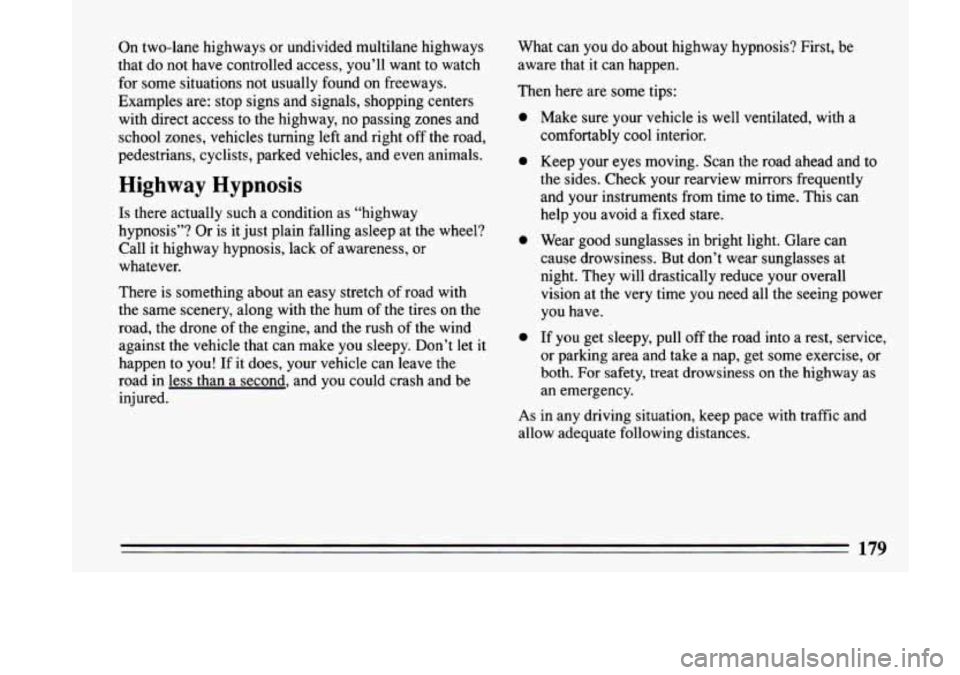
On two-lane highways or undivided multilane highways
that do not have controlled access, you’ll want to watch for some situations not usually found on freeways.
Examples are: stop signs and signals, shopping centers with direct access to the highway, no passing zones and school zones, vehicles turning left and right off the road,
pedestrians, cyclists, parked vehicles, and even animals.
Highway Hypnosis
Is there actually such a condition as “highway
hypnosis”? Or is it just plain falling asleep at the wheel?
Call it highway hypnosis, lack of awareness, or
whatever.
There is something about an easy stretch
of road with
the same scenery, along with the hum of the tires on the
road, the drone of the engine, and the rush of the wind
against the vehicle that can make you sleepy. Don’t let it
happen to you! If it does, your vehicle can leave the
road in less than a second, and you could crash and be
injured. What can you
do about highway hypnosis? First, be
aware that it can happen.
Then here are some tips:
e
e
m
0
Make sure your vehicle is well ventilated, with a
comfortably cool interior.
Keep your eyes moving. Scan the road ahead and
to
the sides. Check your rearview mirrors frequently
and your instruments from time
to time. This can
help you avoid
a fixed stare.
Wear good sunglasses in bright light. Glare can
cause drowsiness. But don’t wear sunglasses at
night. They will drastically reduce your overall
vision
at the very time you need all the seeing power
you have.
If you get sleepy, pull off the road into a rest, service,
or parking area and take a nap, get some exercise, or
both. For safety, treat drowsiness on the highway as
an emergency.
As in any driving situation, keep pace with traffic and
allow adequate following distances.
Page 312 of 324
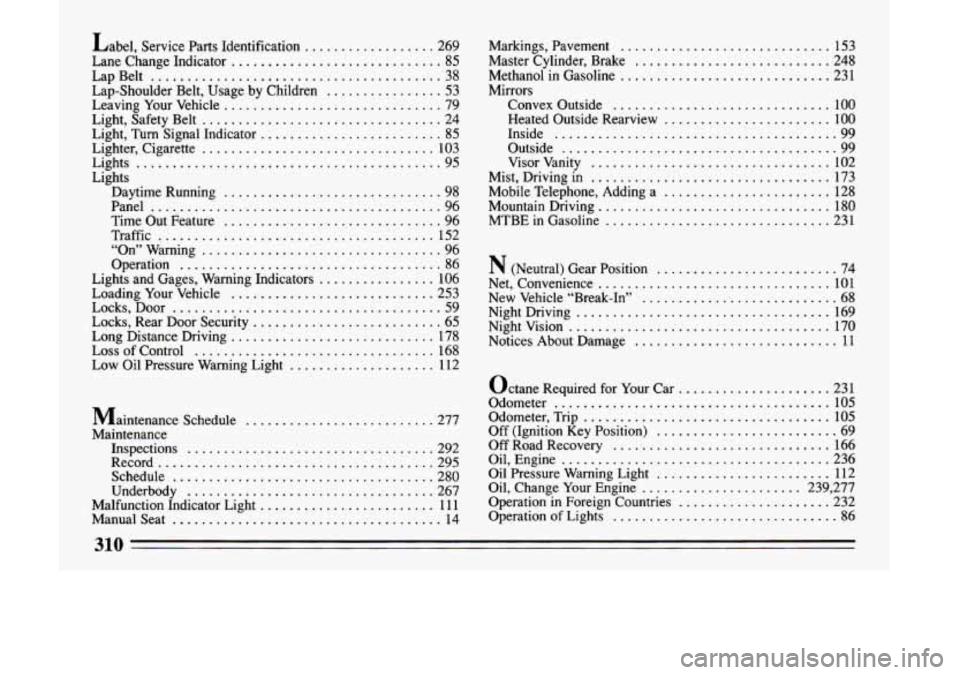
Label. Service Parts Identification .................. 269
Lane Change Indicator
............................. 85
LapBelt
........................................ 38
Lap-Shoulder Belt. Usage by Children
................ 53
Leaving Your Vehicle .............................. 79
Light. Safety Belt
................................. 24
Light.
Turn Signal Indicator ......................... 85
Lighter. Cigarette ................................ 103
Lights
.......................................... 95
Lights
Daytime Running
.............................. 98
Panel
........................................ 96
Time Out Feature
.............................. 96
Traffic
...................................... 152
“On” Warning
................................. 96
Operation
.................................... 86
Lights and Gages. Warning Indicators ................ 106
Loading Your Vehicle
............................ 253
Locks. Door
..................................... 59
Locks. Rear Door Security
.......................... 65
Long Distance Driving ............................ 178
Loss of Control
................................. 168
Low Oil Pressure Warning Light
.................... 112
Maintenance Schedule
.......................... 277
Maintenance Inspections
.................................. 292
Record
...................................... 295
Schedule
.................................... 280
Underbody
.................................. 267
Malfunction Indicator Light
........................ 11 1
Manualseat ..................................... 14 Markings. Pavement
............................. 153
Master Cylinder. Brake ........................... 248
Methanol
in Gasoline ............................. 231
Mirrors Convex Outside
.............................. 100
Heated Outside Rearview
....................... 100
Inside
....................................... 99
Outside
...................................... 99
Visor Vanity
................................. 102
Mist. Driving
in ................................. 173
Mobile Telephone. Adding a
....................... 128
Mountain Driving
................................ 180
MTBE in Gasoline
............................... 231
N (Neutral) Gear Position ......................... 74
Net. Convenience
................................ 101
New Vehicle “Break-In”
........................... 68
NightDriving
................................... 169
Night Vision .................................... 170
Notices About Damage
............................ 11
Octane Required for Your Car
..................... 231
Odometer
...................................... 105
Odometer. Trip
.................................. 105
Off (Ignition Key Position)
......................... 69
Off Road Recovery
.............................. 166
Oil. Engine
..................................... 236
Oil Pressure Warning Light
........................ 112
Operation
in Foreign Countries ..................... 232
Operation of Lights
............................... 86
Oil. Change Your Engine
...................... 239. 277
310 __ .. ~